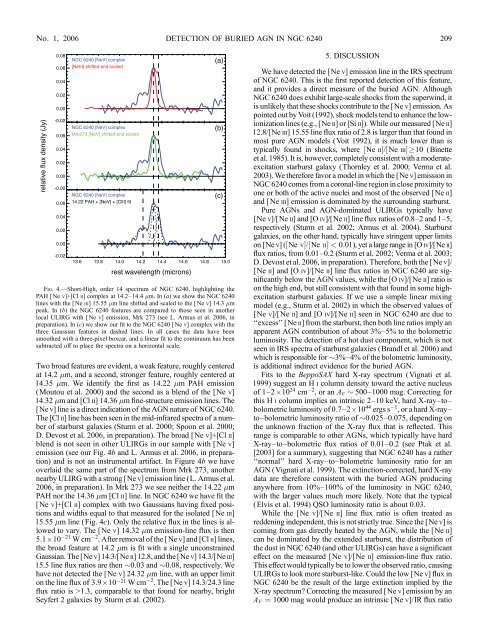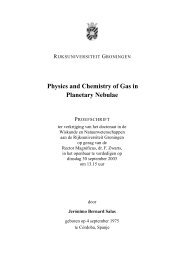ApJ 640, 204 - IRS, The Infrared Spectrograph - Cornell University
ApJ 640, 204 - IRS, The Infrared Spectrograph - Cornell University
ApJ 640, 204 - IRS, The Infrared Spectrograph - Cornell University
You also want an ePaper? Increase the reach of your titles
YUMPU automatically turns print PDFs into web optimized ePapers that Google loves.
No. 1, 2006<br />
DETECTION OF BURIED AGN IN NGC 6240 209<br />
5. DISCUSSION<br />
Fig. 4.—Short-High, order 14 spectrum of NGC 6240, highlighting the<br />
PAH [ Ne v]+[Cl ii] complex at 14.2–14.4 m. In (a) we show the NGC 6240<br />
lines with the [ Ne iii] 15.55 m lineshiftedandscaledtothe[Nev] 14.3m<br />
peak. In (b) the NGC 6240 features are compared to those seen in another<br />
local ULIRG with [ Ne v] emission, Mrk 273 (see L. Armus et al. 2006, in<br />
preparation). In (c) we show our fit to the NGC 6240 [ Ne v] complex with the<br />
three Gaussian features in dashed lines. In all cases the data have been<br />
smoothed with a three-pixel boxcar, and a linear fit to the continuum has been<br />
subtracted off to place the spectra on a horizontal scale.<br />
Two broad features are evident, a weak feature, roughly centered<br />
at 14.2 m, and a second, stronger feature, roughly centered at<br />
14.35 m. We identify the first as 14.22 m PAH emission<br />
(Moutou et al. 2000) and the second as a blend of the [Ne v]<br />
14.32 m and [Cl ii] 14.36 m fine-structure emission lines. <strong>The</strong><br />
[Nev] line is a direct indication of the AGN nature of NGC 6240.<br />
<strong>The</strong> [Cl ii] line has been seen in the mid-infrared spectra of a number<br />
of starburst galaxies (Sturm et al. 2000; Spoon et al. 2000;<br />
D. Devost et al. 2006, in preparation). <strong>The</strong> broad [Ne v]+[Cl ii]<br />
blend is not seen in other ULIRGs in our sample with [Ne v]<br />
emission (see our Fig. 4b and L. Armus et al. 2006, in preparation)<br />
and is not an instrumental artifact. In Figure 4b we have<br />
overlaid the same part of the spectrum from Mrk 273, another<br />
nearby ULIRG with a strong [Ne v] emission line (L. Armus et al.<br />
2006, in preparation). In Mrk 273 we see neither the 14.22 m<br />
PAH nor the 14.36 m [Cl ii] line. In NGC 6240 we have fit the<br />
[Ne v]+[Cl ii] complex with two Gaussians having fixed positions<br />
and widths equal to that measured for the isolated [Ne iii]<br />
15.55 m line (Fig. 4c). Only the relative flux in the lines is allowed<br />
to vary. <strong>The</strong> [Ne v] 14.32 m emission-line flux is then<br />
5:1 ; 10 21 Wcm 2 . After removal of the [Ne v] and [Cl ii] lines,<br />
the broad feature at 14.2 m is fit with a single unconstrained<br />
Gaussian. <strong>The</strong> [Ne v] 14.3/[Ne ii] 12.8, and the [Ne v] 14.3/[Ne iii]<br />
15.5 line flux ratios are then 0.03 and 0.08, respectively. We<br />
have not detected the [Ne v] 24.32 m line, with an upper limit<br />
on the line flux of 3:9 ; 10 21 Wcm 2 . <strong>The</strong> [Ne v] 14.3/24.3 line<br />
flux ratio is >1.3, comparable to that found for nearby, bright<br />
Seyfert 2 galaxies by Sturm et al. (2002).<br />
We have detected the [Ne v] emission line in the <strong>IRS</strong> spectrum<br />
of NGC 6240. This is the first reported detection of this feature,<br />
and it provides a direct measure of the buried AGN. Although<br />
NGC 6240 does exhibit large-scale shocks from the superwind, it<br />
is unlikely that these shocks contribute to the [Ne v] emission. As<br />
pointed out by Voit (1992), shock models tend to enhance the lowionization<br />
lines (e.g., [Ne ii]or[Siii]). While our measured [Ne ii]<br />
12.8/[Ne iii] 15.55 line flux ratio of 2.8 is larger than that found in<br />
most pure AGN models (Voit 1992), it is much lower than is<br />
typically found in shocks, where ½Ne iiŠ/½Ne iiiŠ10 (Binette<br />
et al. 1985). It is, however, completely consistent with a moderateexcitation<br />
starburst galaxy (Thornley et al. 2000; Verma et al.<br />
2003). We therefore favor a model in which the [Ne v] emission in<br />
NGC 6240 comes from a coronal-line region in close proximity to<br />
one or both of the active nuclei and most of the observed [Ne ii]<br />
and [Ne iii] emission is dominated by the surrounding starburst.<br />
Pure AGNs and AGN-dominated ULIRGs typically have<br />
[Nev]/[Ne ii]and[Oiv]/[Ne ii] line flux ratios of 0.8–2 and 1–5,<br />
respectively (Sturm et al. 2002; Armus et al. 2004). Starburst<br />
galaxies, on the other hand, typically have stringent upper limits<br />
on [Ne v](½Ne vŠ/½Ne iiŠ < 0:01), yet a large range in [O iv]/[Ne ii]<br />
flux ratios, from 0.01–0.2 (Sturm et al. 2002; Verma et al. 2003;<br />
D. Devost et al. 2006, in preparation). <strong>The</strong>refore, both the [Ne v]/<br />
[Ne ii] and [O iv]/[Ne ii] line flux ratios in NGC 6240 are significantly<br />
below the AGN values, while the [O iv]/[Ne ii] ratio is<br />
on the high end, but still consistent with that found in some highexcitation<br />
starburst galaxies. If we use a simple linear mixing<br />
model (e.g., Sturm et al. 2002) in which the observed values of<br />
[Ne v]/[Ne ii] and [O iv]/[Ne ii] seen in NGC 6240 are due to<br />
‘‘excess’’ [Ne ii] from the starburst, then both line ratios imply an<br />
apparent AGN contribution of about 3%–5% to the bolometric<br />
luminosity. <strong>The</strong> detection of a hot dust component, which is not<br />
seen in <strong>IRS</strong> spectra of starburst galaxies (Brandl et al. 2006) and<br />
which is responsible for 3%–4% of the bolometric luminosity,<br />
is additional indirect evidence for the buried AGN.<br />
Fits to the BeppoSAX hard X-ray spectrum (Vignati et al.<br />
1999) suggest an H i column density toward the active nucleus<br />
of 1 2 ; 10 24 cm 2 ,oranA V 500 1000 mag. Correcting for<br />
this H i column implies an intrinsic 2–10 keV, hard X-ray–to–<br />
bolometric luminosity of 0:7 2 ; 10 44 ergs s 1 , or a hard X-ray–<br />
to–bolometric luminosity ratio of 0.025–0.075, depending on<br />
the unknown fraction of the X-ray flux that is reflected. This<br />
range is comparable to other AGNs, which typically have hard<br />
X-ray–to–bolometric flux ratios of 0.01–0.2 (see Ptak et al.<br />
[2003] for a summary), suggesting that NGC 6240 has a rather<br />
‘‘normal’’ hard X-ray–to–bolometric luminosity ratio for an<br />
AGN (Vignati et al. 1999). <strong>The</strong> extinction-corrected, hard X-ray<br />
data are therefore consistent with the buried AGN producing<br />
anywhere from 10%–100% of the luminosity in NGC 6240,<br />
with the larger values much more likely. Note that the typical<br />
(Elvis et al. 1994) QSO luminosity ratio is about 0.03.<br />
While the [Ne v]/[Ne ii] line flux ratio is often treated as<br />
reddening independent, this is not strictly true. Since the [Ne v]is<br />
coming from gas directly heated by the AGN, while the [Ne ii]<br />
can be dominated by the extended starburst, the distribution of<br />
the dust in NGC 6240 (and other ULIRGs) can have a significant<br />
effect on the measured [Ne v]/[Ne ii] emission-line flux ratio.<br />
This effect would typically be to lower the observed ratio, causing<br />
ULIRGs to look more starburst-like. Could the low [Ne v] flux in<br />
NGC 6240 be the result of the large extinction implied by the<br />
X-ray spectrum? Correcting the measured [Ne v] emission by an<br />
A V ¼ 1000 mag would produce an intrinsic [Ne v]/IR flux ratio













